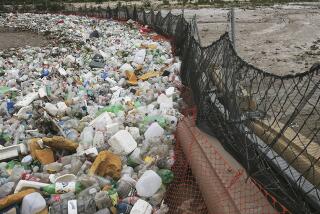Overload Blamed on Dike Delays : Sepulveda Basin: A sewage treatment plant might not have failed during deluge if a long-planned barrier had been built, officials say.
- Share via
Delays in building a long-planned flood control dike caused the shutdown of the Tillman sewage treatment plant late Monday, which in turn contributed to the discharge of more than 30 million gallons of inadequately treated sewage into Ballona Creek, officials acknowledged.
Tillman went off-line when storm waters engulfed three pump motors at the plant in the flooded Sepulveda Basin. City officials said a dike planned since at least 1987 would have protected the equipment and prevented the plant closure.
Because of the shutdown, sewage flowing to Tillman at a rate of up to 110 million gallons per day had to be routed to Los Angeles’ Hyperion Treatment Plant in Playa del Rey. But a brittle, 70-year-old city sewer line, known as the North Outfall Sewer, became overloaded by the addition of the Tillman sewage and storm water.
About 6 p.m. Monday, the excess automatically began flowing into Ballona Creek in West Los Angeles, about six miles upstream of the Hyperion plant and Santa Monica Bay. Officials said the effluent first was partially treated at the North Outfall Treatment Facility, a rudimentary plant built to handle overflows from the ancient sewer main until a replacement line is completed later this year.
By 4 p.m. Tuesday, an estimated 32 million gallons of partially treated effluent had been discharged into the creek to flow into the Pacific Ocean. City public works officials said the overflow continued until Tuesday afternoon but that they could not yet estimate the additional volume.
Rainwater alone would have caused an overflow, said Sam Furuta, a spokesman for the city Bureau of Sanitation. But “certainly Tillman going off-line was a contributing cause and the volume would have been lower if Tillman had been on-line.”
Tillman returned to service at 4:20 p.m. Tuesday, operating at about 80% capacity, plant manager Bob Birk said. He said the plant was expected to be operating at full capacity within hours.
The flooded pump motors were critical to a final stage of treatment in which waste water is chlorinated to kill pathogens and then dechlorinated to avoid possible harm to aquatic life in the Los Angeles River, where Tillman effluent normally is discharged. With the pumps out of commission, officials said sewage had to be routed to Hyperion.
City officials have been planning for years to build a dike around the $130-million plant, because rampant development of surrounding areas had left it vulnerable to a 100-year flood--a storm so severe it has only a 1% chance of occurring in any one year.
City Engineer Robert Horii said Tuesday that he hopes the Army Corps of Engineers, which owns and runs the Sepulveda Basin for flood control, will approve the dike in about three weeks. Construction could then begin by next summer.
“I wish we could have done it faster, but unfortunately it was not done,” said Horii, who cited environmental and technical concerns as reasons for the delay but did not explain in detail why the process took several years.
Gerald Silver, president of Homeowners of Encino and a longtime critic of the Tillman plant, said Monday’s outage raises questions about why the plant was built in the basin in the first place. “Does one put sewage plants in flood plains?” he said. “There was no wisdom in putting it there in the beginning.”
As long ago as 1987, city officials were planning the dike as part of an expansion of Tillman that was completed last September.
But although the Corps of Engineers readily approved the Tillman expansion, it required further environmental and technical analysis of the dike and two other Tillman-related projects, city officials said.
“They said, ‘Go ahead and build the treatment plant, but don’t build the dike until you do the environmental work,’ ” Horii said.
Along with the dike--which is to be 20 to 80 feet wide at the base and from 2 to 15 feet tall--the city is to excavate a huge amount of earth to compensate for the flood storage area the structure will displace.
The excavation, required by the corps, will involve about 567,000 cubic yards of earth--enough to cover a football field to a depth of more than 300 feet. The city will remove that amount by lowering about 123 acres of the basin near Tillman by about three to four feet, Horii said.
He said the excavation will alter the commercial sod farm and model airplane field off Woodley Avenue but will not disturb the wildlife refuge south of the Tillman plant.
A third element of the work will involve relocating the Tillman outfall from the upstream side of Sepulveda Dam to the downstream side to avoid any risk of the outfall being covered in a severe flood.
Horii estimated the cost of the dike, the excavation and the outfall reconstruction at $12 million.
Sanitation officials also corrected a previous estimate that about 10 million gallons of partly treated sewage that had not been chlorinated was discharged Monday night from Tillman. Instead, they said, about 2 million gallons of chlorinated effluent was released into the Los Angeles River without being dechlorinated.
More to Read
Sign up for Essential California
The most important California stories and recommendations in your inbox every morning.
You may occasionally receive promotional content from the Los Angeles Times.










